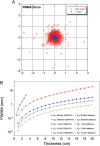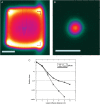Biophysical characterization of a relativistic proton beam for image-guided radiosurgery
- PMID: 22843629
- PMCID: PMC3393345
- DOI: 10.1093/jrr/rrs007
Biophysical characterization of a relativistic proton beam for image-guided radiosurgery
Abstract
We measured the physical and radiobiological characteristics of 1 GeV protons for possible applications in stereotactic radiosurgery (image-guided plateau-proton radiosurgery). A proton beam was accelerated at 1 GeV at the Brookhaven National Laboratory (Upton, NY) and a target in polymethyl methacrylate (PMMA) was used. Clonogenic survival was measured after exposures to 1-10 Gy in three mammalian cell lines. Measurements and simulations demonstrate that the lateral scattering of the beam is very small. The lateral dose profile was measured with or without the 20-cm plastic target, showing no significant differences up to 2 cm from the axis A large number of secondary swift protons are produced in the target and this leads to an increase of approximately 40% in the measured dose on the beam axis at 20 cm depth. The relative biological effectiveness at 10% survival level ranged between 1.0 and 1.2 on the beam axis, and was slightly higher off-axis. The very low lateral scattering of relativistic protons and the possibility of using online proton radiography during the treatment make them attractive for image-guided plateau (non-Bragg peak) stereotactic radiosurgery.
Figures






Similar articles
-
Technical Note: Experimental verification of magnetic field-induced beam deflection and Bragg peak displacement for MR-integrated proton therapy.Med Phys. 2018 Jul;45(7):3429-3434. doi: 10.1002/mp.12961. Epub 2018 Jun 3. Med Phys. 2018. PMID: 29763970
-
An image-guided precision proton radiation platform for preclinical in vivo research.Phys Med Biol. 2017 Jan 7;62(1):43-58. doi: 10.1088/1361-6560/62/1/43. Epub 2016 Dec 14. Phys Med Biol. 2017. PMID: 27973343
-
Fluence correction factors in plastic phantoms for clinical proton beams.Phys Med Biol. 2002 Sep 7;47(17):3055-71. doi: 10.1088/0031-9155/47/17/302. Phys Med Biol. 2002. PMID: 12361210
-
Clinical and radiobiological advantages of single-dose stereotactic light-ion radiation therapy for large intracranial arteriovenous malformations. Technical note.J Neurosurg. 2009 Nov;111(5):919-26. doi: 10.3171/2007.10.17205. J Neurosurg. 2009. PMID: 19392591 Review.
-
Radiation physics for particle beam radiosurgery.Neurosurg Clin N Am. 1992 Jan;3(1):1-8. Neurosurg Clin N Am. 1992. PMID: 1633443 Review.
References
-
- Halperin EC. Particle therapy and treatment of cancer. Lancet Oncol. 2006;7:676–85. - PubMed
-
- Bert C, Engenhart-Cabillic R, Durante M. Particle therapy for noncancer diseases. Med Phys. 2012;39:1716–27. - PubMed
-
- Durante M, Loeffler JS. Charged particles in radiation oncology. Nat Rev Clin Oncol. 2010;7:37–43. - PubMed
-
- Pedroni E, Scheib S, Böhringer T, et al. Experimental characterization and physical modelling of the dose distribution of scanned proton pencil beams. Phys Med Biol. 2005;50:541–61. - PubMed

